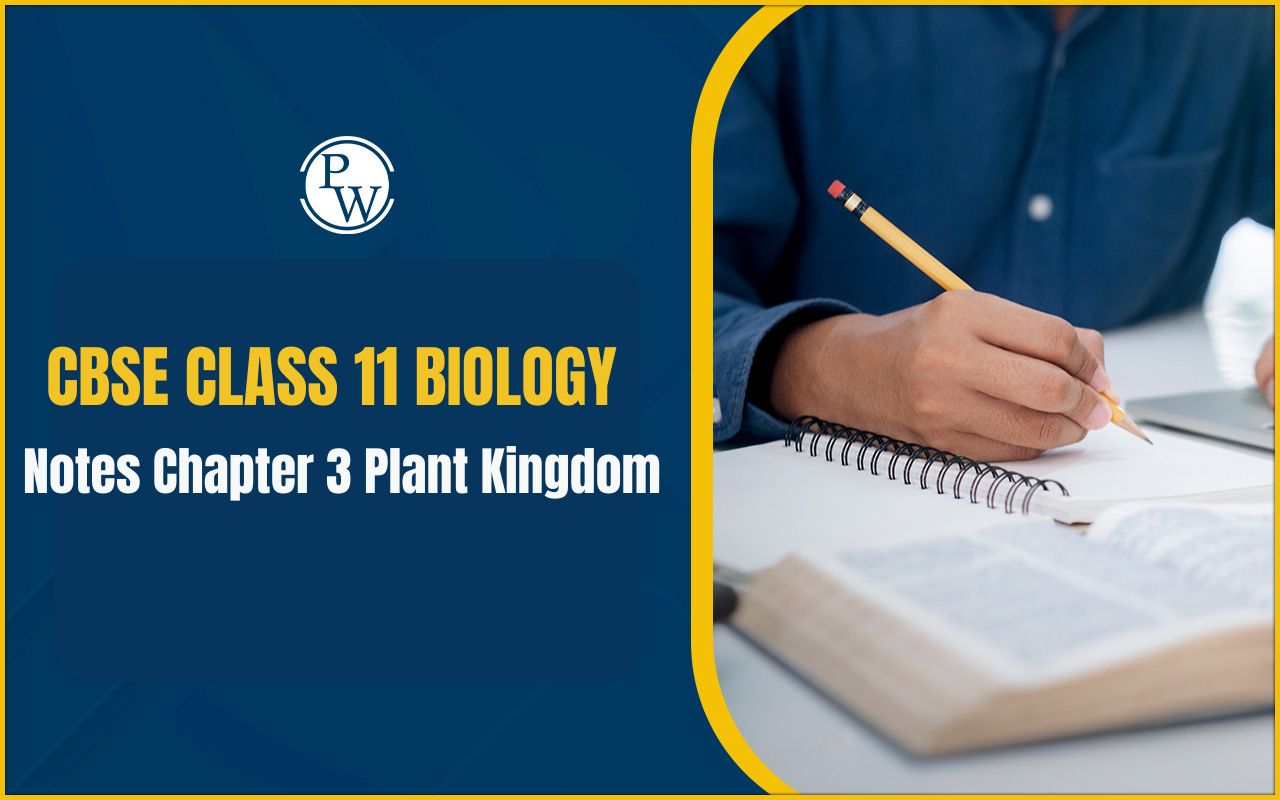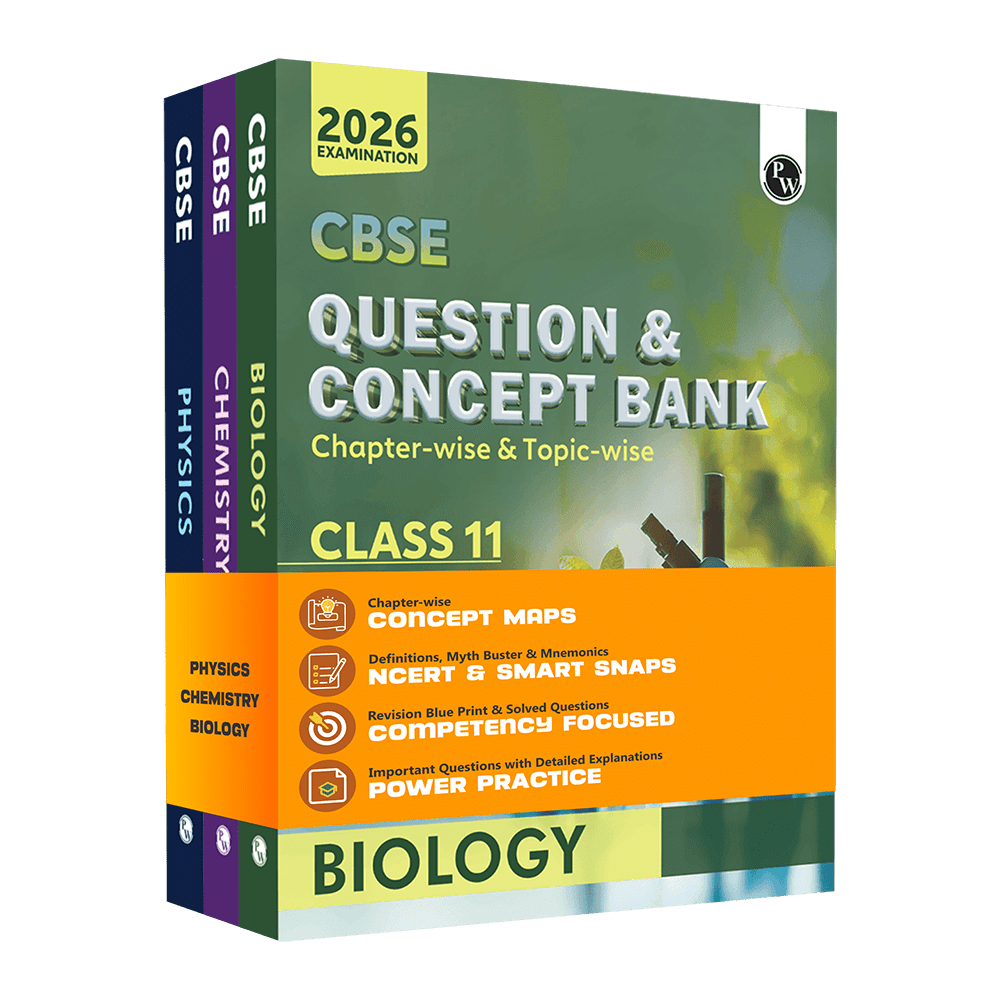CBSE Class 11 Biology Notes Chapter 3 Plant Kingdom

CBSE Class 11 Biology Notes Chapter 3 Plant Kingdom: Class 11 Biology introduces students to the deeper concepts of life sciences and sets the foundation for understanding how living organisms function, grow, and evolve. It covers both the diversity of life and the structure and function of various living systems. One of the most important chapters in this subject is Chapter 3, Plant Kingdom, which focuses on the classification of plants based on their characteristics and evolutionary history.
The Plant Kingdom Class 11 chapter explains in detail how different groups of plants, like algae, bryophytes, pteridophytes, gymnosperms, and angiosperms, are structured and how they reproduce. To help students understand the chapter better and revise quickly, these Plant Kingdom Class 11 Notes have been prepared in simple language. The notes include key concepts, important terms, diagrams, and examples that make learning easier. Whether you are preparing for your school exam or looking for a quick revision before NEET, these Class 11 Biology Chapter 3 Notes are a great support for clear and effective learning.
Check Out: Class 11th Books
CBSE Class 11 Biology Notes Chapter 3 Plant Kingdom
Based on the complexity of the body (unicellular and multicellular), the complexity of the cell structure (prokaryotic and eukaryotic), and the mechanism of nourishment (autotrophs and heterotrophs), Whittaker divided all living things into five kingdoms.
Classification of the Plant Kingdom
Three categories can be applied to all classification schemes, ranging from Aristotle's to the twentieth century:
1. Artificial System: A small number of morphological features serve as the basis for classification in this system.
Theophrastus, Pliny, and Linnaeus employed a fictitious classification scheme.
2. Natural System: All significant connected characters serve as the basis for categorization in this system. both outside and within. A natural system of classification was employed by Bentham, Hooker, Adanson, and Candolle.
3. Phylogenetic System: Plants are categorized according to their evolutionary relationships. It was Eichler, Blessy, Whittaker, Engler, and Prantl, Hutchinson who used phylogeny to classify.
Numerical Taxonomy: Computer-based taxonomy based on statistical techniques of equal weight.
Taxonomy based on cytology or the cellular structure (number of chromosomes, form, behavior, etc.) is called cytotaxonomy .
Chemotaxonomy: Plant taxonomy based on chemical components (protein composition, DNA sequencing, flavor, aroma, etc.).
Plant kingdom classification based on flowering is known as the Eichler classification . separated into two groups: Phanerogamae (flowering, seed-bearing plants) and Cryptogamae (non-flowering, seedless plants).
The three groups of Cryptogamae are Thallophyta, Bryophyta, and Pteridophyta based on the plant body. Thallophyta: The undifferentiated plant body of the species resembles a thallus. Bryophyta: a class of plants with stem- and root-like structures without vascular tissues. Pteridophyta: The real roots, stems, and leaves are distinct parts of the plant body. So-called vascular cryptogams contain vascular tissues.
Thallophytes Again Divided Into:
-
Algae (pigmented thallophytes)
-
Fungi (non-pigmented thallophytes)
-
Lichens: Symbiotic association between algae and fungi.
Phanerogamae is Divided Into Two:
-
Gymnosperms (naked seed plants) and
-
Angiosperma (covered seeded plants)
Angiosperms Are Again Divided Into Two:
-
Monocots (bearing single cotyledon, fibrous root system, and parallel venation)
-
Dicots (have two cotyledons, taproot system, and reticulate venation).
Tracheophytes are the group that includes Gymnosperms, Angiosperms, and Pteridophytes because they have vascular tissue. The Bryophyta, Pteridophyta, Gymnosperms, and Angiosperms are referred to as Embryophyta because of the presence of embryos.
Check Out: Class 11th Question Banks
ALGAE
-
Phycology: Branch of Biology that deals with the study of algae
Phycos = seaweed
Logos = study
-
Fritch –Father of phycology.
-
M.O.P.Iyengar is the father of Indian phycology.
Algal members are pigmented thallophytes.
Habitat
Hydrophytes: Water is their habitat. In aquatic habitat-
-
Freshwater (Spirogyra) and marine (Sargassum).
-
Floating- Chlamydomonas, Spirogyra
-
Benthophytes - These plants remain attached to the bottom of their habitat. Example Chara (stoneworts)
-
Xerophytes: Their habitat is desert.
-
Mesophytes- They grow in medium habitats.
-
Epiphytes- They grow on plant bodies (Cladophora)
-
Epizoic-growing on the animal body (Trichophillus)
-
Lithophytes- They grow on rocks.
-
Halophytes- They grow in salty areas.
-
Moist soil-terrestrials (Fritschiella).
Plant Body
A haploid gametophyte is the body of an algal vegetative plant. They could have one or more cells, be flagellated (Chlamydomonas), or not (Chlorella). Multiple cells: a) Coenobium: This is a colony with a predetermined number of cells and labor division. For instance, Volvox
b) Aggregation-indefinite colony. Eg: Tetraspora
c) Filamentous-unbranched.Eg: Ulothrix
d) Filamentous branches. Eg: Cladophora
e) Siphonous- multinucleate. Eg: Vaucheria
f) Parenchymatous. Eg: Ulva the,
g) Branched like higher plants. Eg: Sargassum, Chara
Read More: NCERT Solutions for Class 11 Biology Chapter 1
Nutrition
-
Autotrophs - Photosynthetic (most of them)
-
Parasitic forms (rare). E.g.: Cephaleuros.
Pigments
-
Chlorophyll- a, b, c, d.
-
Carotenoids- carotene and xanthophyll-fucoxanthin are dominating pigments in brown algae.
-
Phycobillins- phycocyanin and phycoerythrin.
Reproduction
-
Vegetative reproduction- Reproduction Using the Vegetative Parts.
Different Types are:
-
Fission
-
Fragmentation
-
Budding
-
Tubers
-
Gemmae.
-
Asexual Reproduction-Without the Fusion of Gametes.
Mainly by:
-
Zoospores within sporangia
-
Aplanospores
-
Akinete
-
Hypnospores
-
Endospore
-
Exospore
-
Monospore
-
Auxospore.
Palmella Stage- In this stage of asexual reproduction the spores become colonial and appear like the algae named Palmella. Eg: Ulothrix, Chlamydomonas.
-
Sexual Reproduction
Homogametes-similar gametes
Heterogametes-dissimilar gametes
1. Isogamy: the union of comparable gametes in terms of morphology and physiology. Flagellated (Chlamydomonas) and non-flagellated (Spirogyra) are examples of isogamy. 2. Anisogamy: the union of gametes with different morphologies or physiological profiles. In Chlamydomonas, morphologically distinct gametes fuse. In Spirogyra, the fusing of physiologically different gametes takes place. 3. Oogamy: This is the union of two different types of gametes—a large, nonmotile female gamete and a small, motile male gamete—that differ in both morphology and physiology. For instance, Fucus and Volvox.
-
Exceptional Cases:
Unicellular antheridium and oogonium.E.g.: Oedogonium.
-
Special Reproductive Structures:
Conceptacles –Eg: Sargassum
Globule (antheridium) and nucule (oogonium) Eg: Chara
In spirogyra, a unique kind of sexual reproduction known as conjugation occurs. The life cycle is divided into two phases: diploid and haploid, with some exhibiting generational alternation. The haploid phase and the diploid phase alternate.
-
Classified Into Four Classes:
1. Cycadopsida Eg: Cycas
2. Coniferopsida eg: Pinus
3. Gnetopsida: Eg: Gnetum.
4. Gingopsida- Ginko
Read More: NCERT Solutions for Class 11 Biology Chapter 2
Economic Importance:
-
Timbers for furniture, Pulpwood, Pencil boxes, Musical instruments, etc.
-
Production of resins, Turpentine etc.-E.g.-Pinus
-
Edible seeds: Eg- Cycas, Pinus, Ginkgo.
-
Medicinal Eg: Ephedrine from Ephedra is used in treatment for respiratory problems
-
Taxol – from Taxus species are extracted to freeze cancer cells.
Common Names:
-
Maidenhair tree- Ginkgo
-
Sago's palm is called the Panda of the plant kingdom- Cycas
-
Largest gymnosperm- Sequoia
-
Smallest gymnosperm- Zamia
-
Gymnosperm with xylem vessels- Ephedra, Gnetum.
Gymnosperms
possess naked seeds since the ovules are left exposed (no fruit covering) and are not encased in or by an ovarian wall. Plants yield seeds without flowers. The ovarian wall does not surround ovules either. prevailing vegetation in the Jurassic era. Shrubs and medium-sized or taller trees are classified as gymnosperm. The taproot system is typically found. They are also connected to mycorrhiza, the relationship that fungi have with the roots of higher plants. For instance, Pinus. Like in Cycas, coralloid roots contain bacteria that fix nitrogen. Pinus or Cycas refer to branching or unbranched stems. Leaves with thick cuticles and recessed stomata are shaped like needles, suited to withstand extremes in temperature, humidity, and wind. For instance, Pinus. Leaves might be complicated or simple.
Reproductions
Cones or stromboli are created when sporophylls group together. Generally speaking, they are either male or female cones or monosporangiate. Female cones have a longer lifespan than male cones. Male strobili, also known as male cones, are microsporophylls that carry microsporangia, which contain microspores that grow into smaller gametophytes known as pollen grains. Nucellus, also known as the female cone or female strobili, are megasporophylls bearing megasporangium that contain encased megaspores. A female gametophyte containing two or more archeonies emerges from a single megaspore. Pollen grains go to the ovules via wind-borne strands. To discharge male gametes into the ovule, they construct a pollen tube that reaches the archegonia. After the gametes fuse, a zygote is created, which gives rise to embryos. Ovules become uncoated seeds throughout development. Gymnosperm endosperms are haploid in origin and resemble a prefertilized result. The sporophyte is the predominant independent photosynthetic stage. The gametophyte is not a free-living organism; it can have one or a few cells.
Alternation of Generation
A haploid gamete that produces both gametophytic and spore-producing sporophytic generation alternates. Three kinds Haplontic Life Cycle: In this kind of life cycle, haploid spores generate a free-living gametophyte that is the dominant photosynthetic phase. Using mitosis, the gametophyte generates gametes, which unite to create the zygote, symbolizing the sporophytic generation. To create haploid spores, the zygote goes through the meiotic process. In this case, the gametophytic phase predominates. such as Chlamydomonas.
Diplontic Life Cycle: In this case, the photosynthetically independent and dominant diploid sporophyte stage of the plant is involved. One to a few celled haploid gametophytes that nourish is the representation of the gametophytic phase. For example, in the case of angiosperms and gymnosperms, the sporophytic phase is dominant.Haplo-Diplontic Life Cycle: This type of organism has multicellular, largely free-living haploid and diploid phases. As examples, consider bryophytes and pteridophytes.
While most algae genera have demonstrated a haplontic life cycle, examples of these include Ectocarpus, Polysiphonia, Kelps, etc. However, a haplo-diplontic life cycle is also present in some. Brown algae called fucus have a diplontic life cycle.
Check Out: CBSE Class 11 Question Bank Biology Chapter-wise and Topic-wise Solved Questions For 2026 Exams
Summary of CBSE Class 11 Biology Plant Kingdom
-
Plant Kingdom is a major group under Kingdom Plantae which includes all types of plants ranging from simple algae to complex flowering plants.
-
The chapter explains the classification of plants based on their body structure, mode of reproduction, and presence or absence of vascular tissues.
-
The five main groups of the Plant Kingdom are:
-
Algae – Simple, aquatic, autotrophic plants without roots, stems, or leaves.
-
Bryophytes – Non-vascular plants often called amphibians of the plant kingdom.
-
Pteridophytes – First vascular plants with true roots, stems, and leaves.
-
Gymnosperms – Seed-producing plants without flowers; seeds are naked.
-
Angiosperms – Flowering plants with seeds enclosed in fruits.
-
Algae are mainly aquatic and reproduce through fragmentation, spores, or gametes.
-
Bryophytes and pteridophytes show alternation of generations, with a dominant gametophyte and sporophyte stage respectively.
-
Gymnosperms and angiosperms are seed-producing plants that show advanced vascular tissues and reproductive systems.
-
Angiosperms are further divided into monocots and dicots based on the number of cotyledons in the seed.
-
Life cycle patterns of different plant groups and their evolutionary significance are also discussed in this chapter.
Also Check, CBSE Class 11 Chapterwise 20 Most Probable Questions Physics, Chemistry, Biology and Mathematics For 2026 Exams
Benefits of CBSE Class 11 Biology Notes Chapter 3 Plant Kingdom
The Class 11 Biology Chapter 3 notes are extremely helpful for students who want to understand the Plant Kingdom in a simple and quick way. Check out the Benefits of CBSE Class 11 Biology Notes Chapter 3 Plant Kingdom:-
-
Quick and Clear Understanding: The Class 11 Biology Chapter 3 notes explain all the important topics like plant classification, characteristics, and life cycles in simple and easy language.
-
Time-Saving Revision Tool: These Chapter 3 Biology Class 11 notes help students revise faster before exams by covering all key definitions, examples, and diagrams in one place.
-
Helpful for NEET and Competitive Exams: The notes focus on exam-relevant content, making them useful not only for school exams but also for competitive exams like NEET.
-
Well-Organised and Student-Friendly: The Biology Class 11 Chapter 3 notes are neatly structured, which helps students study topic-wise without confusion or overload.
-
Boosts Confidence and Retention: By using these notes regularly, students can strengthen their basics, clear doubts easily, and feel more confident while attempting Biology questions in exams.
CBSE Class 11 Biology Notes Chapter 3 FAQs
1. What is the Plant Kingdom in Class 11 Biology?
In Class 11 Biology Chapter 3, the Plant Kingdom refers to the classification of plants into groups like algae, bryophytes, pteridophytes, gymnosperms, and angiosperms based on their features and reproduction.
2. Why is Chapter 3 important in Biology Class 11?
Chapter 3 Biology Class 11 notes are important because they form the base for higher-level botany and help in understanding plant diversity, classification, and evolution.
3. How many types of plants are discussed in Chapter 3?
There are five major types discussed: algae, bryophytes, pteridophytes, gymnosperms, and angiosperms.
4. Are Biology Class 11 Chapter 3 notes useful for NEET?
Yes, many NEET questions come from this chapter. Well-prepared Class 11 Biology Chapter 3 notes help in quick revision and strong concept clarity.
5. What are bryophytes and why are they called amphibians of the plant kingdom?
Bryophytes are non-vascular plants that need water for reproduction. They are called amphibians because they live on land but need water to reproduce.











